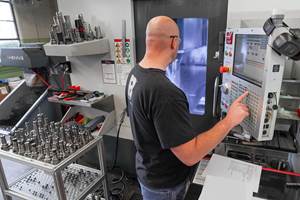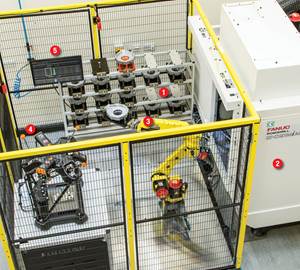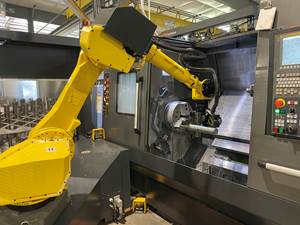Automation's Essence
The greater achievement is the clarity and care, not the hardware.
Share





Automation is one of the most important themes transforming metalworking. This has been and will continue to be true. I think most reading these words would agree with that. But when we say “automation,” what do we mean?
Many picture a robot. In a machine shop, it’s a robot loading parts. But what makes this robot possible? Answer: a job in which the part always goes into and out of the machine the same way. Once the shop recognizes this repetitiveness or engineers the process to achieve it, installing a robot to perform the task is straightforward.
But why is the robot there? Not to replace employees. Truly, not this. People want to work with people. Among other things, coworkers and employees help us find meaning in the work.
No, the robot is there to replace uncertainty. Throughout the shop, not all employees are equally productive and most are rarely at their best. Plus, employees are prone to stop their output for reasons that are hard to fathom. By comparison, the robot produces without stopping, without variation. And the robot can keep producing into the hours when the shop has no employees present.
But now come back to what makes that robot possible—the repetitiveness. That is, the rule. When the cycle ends, unload a part and load a new one. Where else in the shop is it possible to find or engineer that kind of repetitiveness, that clarity? When this happens, do that. When X happens, do Y.
Maybe X and Y are in different parts of the shop, meaning a stationary robot can’t connect them. But that’s OK, because now that I see that we’re talking about the system underlying the robot, I realize that we’re talking about something bigger and more powerful than any piece of hardware. Why is that employee’s performance unpredictable? Could it be that this is also for lack of an organized system? Maybe he finds himself in a confusing situation and has stopped cold because he is doing his best to puzzle through it.
Clear signals, clear instruction, clear objectives, lack of distraction. When X happens, do Y. The repetitiveness is what makes the robot possible. Meanwhile, the care of delineating a clear system is what sets the employee free. When we talk about automation, this is what we’re talking about. It’s not the robot, because once you have the system, the robot is the easy part. The system is the key. Some simple rules are best carried out by machines, but when the rules call for discernment, judgement, recognition or mobility, then something better will fill this role.
An employee is the very best robot. Algorithms are essential for a robot, while clear and understandable procedures are liberating for an employee. They are alike in this respect. But one of the important differences is that the employee is capable of joy—joy in doing good work—and in that joy, he or she might discover the way toward even better procedures that more readily attain the goal. When we talk about automation, this is what we mean: systemization. And when we talk about systemization, we mean not just repetitiveness, not just consistency, but also clearing away enough confusion that we can imagine the next way forward.
Related Content
Studer's Automation, Entry-Level Solutions Take Center Stage
At its 2024 Music Motion Meeting, Studer AG showed off its entry-level line of grinding machines, as well as its newest universal loading system.
Read MoreMedical Shop Performs Lights-Out Production in Five-Axes
Moving to five-axis machining enabled this shop to dramatically reduce setup time and increase lights-out capacity, but success relied on the right combination of workholding and automation.
Read More5 Stages of a Closed-Loop CNC Machining Cell
Controlling variability in a closed-loop manufacturing process requires inspection data collected before, during and immediately after machining — and a means to act on that data in real time. Here’s one system that accomplishes this.
Read MoreSame Headcount, Double the Sales: Successful Job Shop Automation
Doubling sales requires more than just robots. Pro Products’ staff works in tandem with robots, performing inspection and other value-added activities.
Read MoreRead Next
AMRs Are Moving Into Manufacturing: 4 Considerations for Implementation
AMRs can provide a flexible, easy-to-use automation platform so long as manufacturers choose a suitable task and prepare their facilities.
Read MoreMachine Shop MBA
Making Chips and Modern Machine Shop are teaming up for a new podcast series called Machine Shop MBA—designed to help manufacturers measure their success against the industry’s best. Through the lens of the Top Shops benchmarking program, the series explores the KPIs that set high-performing shops apart, from machine utilization and first-pass yield to employee engagement and revenue per employee.
Read More



















